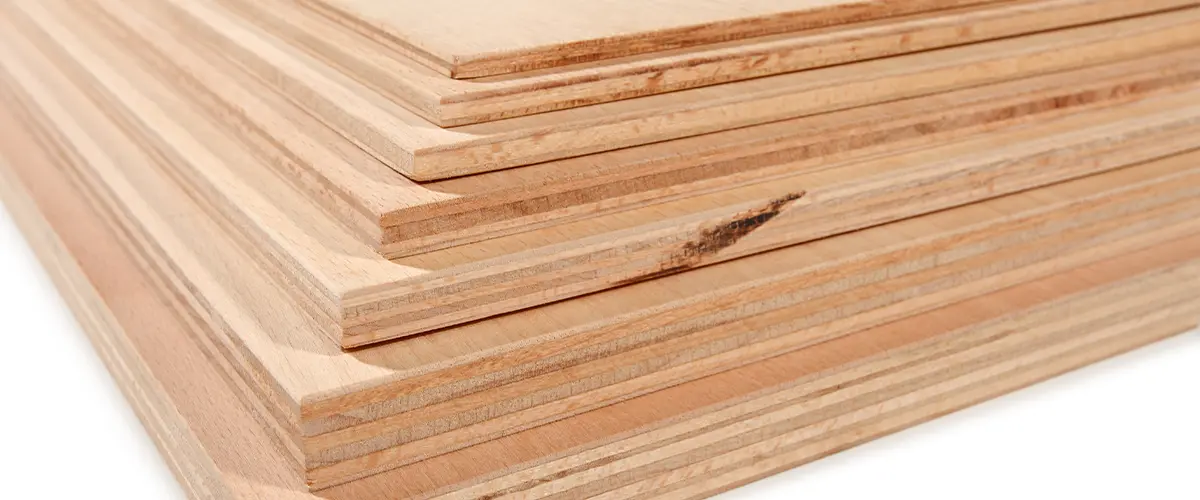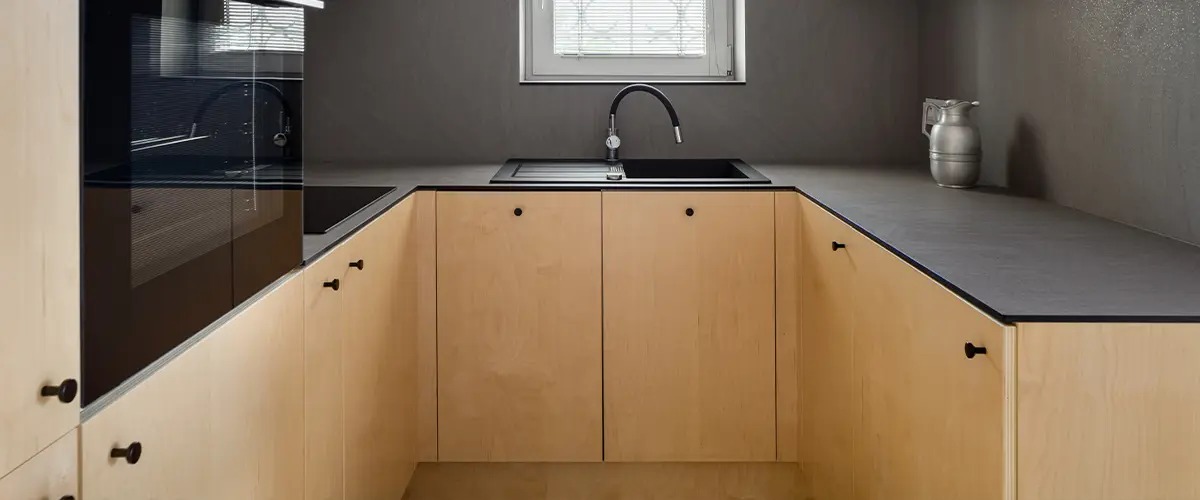Best Plywood For Kitchen Cabinets In Springfield
Choosing the right plywood for kitchen cabinets can be tricky for many homeowners in Springfield. One interesting fact is that not all plywood is created equal, especially when it comes to durability and appearance for cabinet construction.
This article will guide you through selecting the best plywood to ensure your kitchen cabinets are both beautiful and long-lasting. Keep reading to find out how.

Key Takeaways
- Plywood is made of layers glued together, making it strong and stable for kitchen cabinets.
- Different types of plywood like birch, maple, and oak offer various looks and qualities for customizing your cabinets.
- Understanding plywood grades (A to D) helps you choose the right quality for durability and appearance in your kitchen.
- When buying plywood, check its flatness and smooth edges to ensure high - quality cabinet construction.
- Maintaining plywood cabinets involves regular cleaning with mild soap, applying protective finishes, and promptly addressing any damage.
Understanding Plywood for Cabinets
What is Plywood?
Plywood is made from thin layers of wood veneer glued together under high pressure. Each layer, or “ply,” goes in different directions for added strength. This unique construction makes the material very stable and resistant to warping.
Plywood comes in various types and grades, making it a versatile choice for furniture, cabinets, and even wall panels.
Homeowners prefer plywood for kitchen cabinets because of its durability and smooth surface. It can support heavy countertops and resist water damage better than other materials like particle board or MDF (medium-density fiberboard).
With finishes ranging from maple to birch or oak, plywood offers both beauty and functionality to your cabinetry projects.
Common Types of Plywood for Cabinets
Choosing the right plywood for your kitchen cabinets is crucial. It affects durability, appearance, and cost.
Here are some common types:
- Birch plywood stands out for its smooth surface. This makes it ideal for painting or staining, offering a neat finish to cabinet doors.
- Maple plywood brings a subtle grain pattern. Homeowners prefer it for its uniform appearance that complements both contemporary and traditional kitchens.
- Marine plywood is known for its water - resistant qualities. Although more expensive, it's perfect for areas prone to moisture, ensuring longevity.
- Oak plywood provides a distinct grain pattern, adding character to your cabinets with its rich texture. It’s a strong choice for those seeking durability without compromising on style.
- Cherry plywood offers an elegant look with its fine grain and warm hues. Cabinets made from cherry plywood stand out in any kitchen due to their high-quality appearance.
- Veneer core plywood features layers of thin sheets, making it sturdy yet lightweight; suitable for wall cabinets that hold less weight but need strong support.
- Cabinet-grade plywood is specifically designed for building cabinet boxes with its higher quality standards in mind — thicker veneers and fewer defects ensure a polished look and feel.
Plywood Sizing and Grading
| Sizing | Grading |
|---|---|
| Plywood comes in various sizes, with the most common being 4 feet by 8 feet sheets. | Grades range from A to D, where A represents the highest quality with minimal imperfections. |
| Thickness varies, typically between 1/8 inch to 3/4 inch, depending on the application. | B grade still has a smooth surface, but minor blemishes are allowed. |
| Custom sizes can be ordered for specific projects, ensuring minimal waste. | C grade shows more knots and discoloration, acceptable for parts of the cabinet less visible. |
| Always verify the actual size as nominal sizes may not reflect exact dimensions. | D grade plywood is the lowest quality, often used for structural supports where appearance is not critical. |

Choosing the Best Plywood for Kitchen Cabinets in Springfield
Important Factors to Consider (Flatness, Edge Inspection, etc.)
- Ensure the plywood is flat to avoid warping or unevenness in your cabinets.
- Thoroughly inspect the edges of the plywood to ensure they are smooth and free from defects.
- Check for consistent thickness throughout the sheet for uniformity in your cabinet construction.
Recommended grades of plywood (A, B, C, D)
When choosing plywood for kitchen cabinets, consider the grades carefully. Grade A signifies the highest quality with minimal defects and smooth surfaces suitable for clear finishes.
Grade B offers good appearance but allows for more imperfections. Grade C may include some knots and discoloration, while Grade D is best used when a rustic look is desired, as it features numerous imperfections.
For homeowners in Springfield, selecting the right grade of plywood ensures that your kitchen cabinets will meet both aesthetic and functional needs. Keep in mind these grades – A, B, C, D – to make an informed decision based on your desired cabinet appearance and budget constraints.
Types of plywood (softwood, hardwood, decorative)
- Softwood plywood: Made from softwood trees like pine or cedar, suitable for structural applications due to its strength and affordability.
- Hardwood plywood: Crafted from hardwood trees such as oak or birch, ideal for visible surfaces due to its attractive grain patterns and durability.
- Decorative plywood: Designed with veneer faces of different wood species, perfect for creating aesthetically pleasing cabinetry with a variety of finishes.
Tips for Working with Plywood for Cabinets
How to Buy Plywood and Cutting Tips
- Choose the right type of plywood based on your cabinet design and budget, such as softwood or hardwood.
- Ensure the plywood is flat and has smooth edges to avoid issues during installation.
- Select the appropriate grade of plywood (A, B, C, or D) based on the desired appearance and durability.
- Consider the thickness of the plywood needed for your cabinets, typically ranging from one - eighth to one inch.
- Look for water - resistant plywood if your cabinets will be installed in areas prone to moisture.
- When cutting plywood, use a sharp blade and support the sheet adequately to avoid chipping or splintering.
- Consider edge band treatment to cover exposed edges for a finished look.
Finishing and Maintenance Suggestions
- Clean the surfaces regularly using a damp cloth and mild soap to remove dirt and grease.
- Apply a protective finish such as varnish or lacquer to seal and protect the plywood from moisture and stains.
- Avoid using abrasive cleaners or harsh chemicals that can damage the finish and expose the plywood to potential harm.
- Inspect for any signs of wear or damage, and promptly repair or refinish affected areas to prevent further deterioration.
- Keep the cabinet interiors dry and well-ventilated to prevent mold and mildew growth, especially in humid environments like kitchens.
- Use furniture polish or wax occasionally to restore shine and luster to your plywood cabinets while providing an extra layer of protection.
Troubleshooting common issues
- Warping and Bowing: Check for proper installation, humidity levels, and consider reinforcing supports if needed.
- Delamination: Ensure adequate glue coverage during assembly, and seal edges to prevent moisture ingress.
- Surface Imperfections: Sand down rough spots, apply wood filler as needed, and finish the surface to restore smoothness.
- Moisture Damage: Investigate potential leaks or high moisture areas, and consider water-resistant plywood for replacements.
- Joint Separation: Re-glue loose joints using clamps for proper adhesion.
Selecting the Best Manufacturers for Kitchen Cabinets

